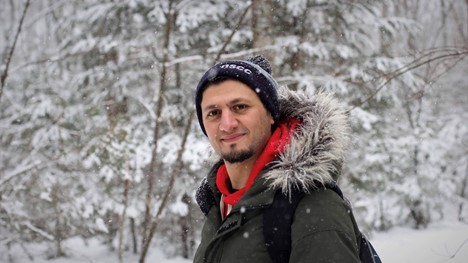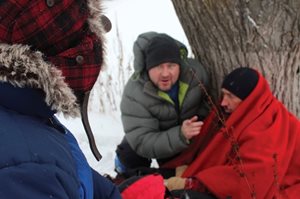
By Jennifer Barnable, senior digital writer
In this series, newcomers will learn how to be better prepared for the risks and realities that come with Canadian winter. Discover practical tips for cold weather safety, first aid, and emergencies like snowstorms and power outages.
Winter is coming this way and with it, newcomers who are about to experience their very first Canadian winter.
Many arrive with a romantic impression of a snowy Canada – perfect postcard images of snowy destinations, and excitement to capture their own winter wonderland memories to share on social media. This idealized impression of life in a snowy country, however, may distract from some important realities our newcomer friends will encounter this winter.
For all of its beauty, Canada’s winters can be harsh, long, and full of unexpected or hidden dangers. Luckily, with some practical cold climate planning and winter safety knowledge, new Canadians can arrive ready for real life winter situations.
Don Marentette, director of first aid programs at the Canadian Red Cross, wants newcomers to be aware of and well prepared for common risks during Canada’s coldest season.
“Winter can be overwhelming, even for people who have lived in Canada all their lives. Not only are newcomers experiencing a new climate, they’re also exploring a new outdoor world with different risks they may not realize,” Don explains.
“Lakes and ponds are beautiful when frozen, winter sports can be exciting, and experiencing traditional Canadian winter activities will be part of some important first memories,” Don says. “The Canadian Red Cross wants to make sure those memories are positive ones, free of injuries and illnesses if possible – and if an emergency happens, we want our new neighbours to feel confident in how to respond.”
Common cold-weather dangers
 Newcomers may be unaware of the dangers and the signs of the two most common cold-related emergencies: frostbite and hypothermia.
Newcomers may be unaware of the dangers and the signs of the two most common cold-related emergencies: frostbite and hypothermia.
Frostbite is a serious condition in which body tissues freeze and are damaged – especially the fingers, toes, ears, and nose. Before frostbite occurs, a person’s skin may appear shiny and rosy. This is a warning sign that frostbite is about to set in.
Hypothermia can be life threatening. It occurs when a person is exposed to cold temperatures too long, resulting in a drop in body temperature, accompanied by shivering, numbness, lack of coordination, confusion and unusual behaviour.
Don explains, “We offer a First Aid Basics course that is a great fit for newcomers. It’s delivered in a flexible format and is available in multiple languages. The workshop covers essential first aid skills, and can be tailored to the audience to include topics of interest to them, such as how to recognize and treat someone suffering from a cold-related emergency like frostbite or hypothermia.”
 “Newcomers also learn useful skills for dealing with common wintertime injuries, helping them feel more confident and prepared,” he says.
“Newcomers also learn useful skills for dealing with common wintertime injuries, helping them feel more confident and prepared,” he says.
Don recommends these practical tips for staying warm and safe in Canadian winters.
He adds, “By being prepared in the basics of first aid, newcomers can better identify, avoid and respond to common injuries and emergencies, including those that often occur during winter months.”
Newcomers offer advice from personal experience
Atlantic Canada’s largest newcomer support agency, Immigrant Services Association Nova Scotia (ISANS), helps immigrants build a future through integration services in settlement, employment, language, business, and community connections.
Their staff, many who are immigrants themselves, work to guide and assist thousands of clients starting a new life in Nova Scotia, where Canadian winters can hit hard.
 Mohammad Al Masalma is an orientation services coordinator at ISANS and leads newcomer workshops to provide guidance and resources for newcomers to Canada so that they can smoothly settle into their lives in a new home. He also speaks from personal experience.
Mohammad Al Masalma is an orientation services coordinator at ISANS and leads newcomer workshops to provide guidance and resources for newcomers to Canada so that they can smoothly settle into their lives in a new home. He also speaks from personal experience.
“We cover topics like health, education, banking, law and also the seasons,” Mohammad explains. “I also lead ‘Winter in Canada’ workshops where we talk about how to prepare, including the best clothing for Canadian winter, and how to prepare for power outages, snowstorms, and winter injuries. We share practical seasonal home safety tips and mental health tips during the long winter.”
Mohammad’s advice for newcomers? “Be ready for the long winter, and buy your winter jackets and footwear in Canada, not from your home country, because it is made for the Canadian winter.”
Wellness for long winters
Once the initial winter wonder begins to fade, the everyday reality of winter starts to sink in. Winter in Canada can feel like it will last forever, with short days, dark nights and cold, constantly changing weather.
“During my first winter in Canada, at first I was very excited to see so much snow. I would spend as much time outside as possible,” Mohammad recalls. “I used to send a lot of photos to my family back home and tell them how beautiful the winter is here, but after a couple of months of snowstorms and freezing cold, I became less excited. Finally, towards the end of the winter season, I was more than ready to be done with the winter.”
He adds, “It was my own first Canadian winter experience that helped me realize why people would travel to hot countries like mine during wintertime. After I lived through winter in Atlantic Canada, I knew why!”
Make a winter season plan
Maintaining wellness can be a challenge in wintertime, especially for people who have never experienced long periods of coldness and darkness. Pace yourself during the winter months, plan a variety of activities and hobbies for days you cannot go outside in cold or stormy weather.
Making a winter season plan with milestones can help keep spirits up when winter feels a little too long. Add projects, movie nights, quality time with the people and pets in your life, and anything else that keeps things interesting.
Finding ways to connect with others and to feel grounded have become even more important during the COVID-19 pandemic. Finally, it’s natural that newcomers face increased stress when moving to a new country and adjusting to a new culture, language and climate. Taking the time to adjust is part of the process.
Consider psychological first aid training
 “The Canadian Red Cross also offers Psychological First Aid courses to help people, newcomers included, take care of themselves and others during stressful times,” Don explains.
“The Canadian Red Cross also offers Psychological First Aid courses to help people, newcomers included, take care of themselves and others during stressful times,” Don explains.“These courses can be completed online or in person with an instructor. There are two self-directed, online courses: ‘Self-Care,’ for building personal resilience, and ‘Caring for Others,’ to learn skills for helping those around you cope with stress.” He adds, “Both are quick, accessible courses teaching practical skills to use in daily life.”
Stay tuned for Part 2 of Welcome to Canadian winter, coming soon. Next time, we’ll focus on how to dress properly for our winter climate and learn from newcomers' firsthand experiences. Until then, more practical tips for preventing, recognizing and responding to cold-related emergencies can be found here.
Are you a newcomer to Canada and want to learn first aid? Sign up for our First Aid Basics Workshop or Psychological First Aid courses. Download the free, interactive First Aid App to keep practical winter first aid tips in your pocket.
Related Stories:

